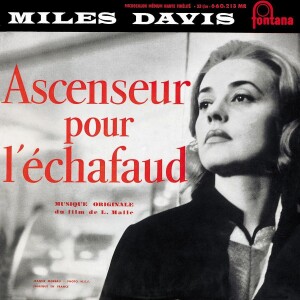 This is a one-of-a-kind album, an audio documentary of the making of a movie soundtrack by Miles Davis, as he was poised on the brink of his big popular breakthrough. Davis was in France for a brief tour with a quartet in the winter of 1957 when he was asked to provide music for a film by the young director Louis Malle. He and a quartet of musicians went to a makeshift studio for a private screening of Malle’s film, Ascenseur pour l’echafaud (translated variously as “Lift to the Scaffold” or “Elevator to the Gallows”) and improvised the music for the soundtrack. Miles had been given a previous showing of the film and told what the director wanted, so he had a few days to work on some sketches before the recording date.
This is a one-of-a-kind album, an audio documentary of the making of a movie soundtrack by Miles Davis, as he was poised on the brink of his big popular breakthrough. Davis was in France for a brief tour with a quartet in the winter of 1957 when he was asked to provide music for a film by the young director Louis Malle. He and a quartet of musicians went to a makeshift studio for a private screening of Malle’s film, Ascenseur pour l’echafaud (translated variously as “Lift to the Scaffold” or “Elevator to the Gallows”) and improvised the music for the soundtrack. Miles had been given a previous showing of the film and told what the director wanted, so he had a few days to work on some sketches before the recording date.
The combo comprised Barney Wilen on tenor, Rene Urtreger on piano, Pierre Michelot on bass and Kenny Clarke on drums. As described by Michelot in an interview in 1988 for this CD reissue, the sessions amounted to a pre-rehearsal for what was to become Davis’ most popular album, Kind of Blue, which he recorded in New York just 15 months later. Said Michelot, “What was typical of this session was the absence of a specific theme. This was new for the period, especially with the soundtrack for a film. … Save for one piece … we only had the most succinct guidance from Miles. In fact, he just asked us to play two chords — D minor and C7 — with four bars each, ad lib. That was new, too, the pieces weren’t written to a specific length.”
In other words, the beginnings of Davis’ experimentation with what came to be called “modal” jazz.
When the soundtrack album was released, it had 10 tracks, distilled from 16 recorded in about four hours on the night of Dec. 4, 1957. All 26 tracks are presented here, with the rehearsal takes leading up to the final versions making up the first 16 tracks. The final 10 tracks are the final takes as they appeared in the film and the original record, with echo added to the trumpet and occasionally the sax.
It’s all a fascinating listening experience for the Miles Davis fan, particularly those who like Kind of Blue-era Davis. There’s a mix of tempos and instrumentation, some tracks featuring just bass, drums and trumpet, others with different mixes, including one, “Ascenseur,” that’s a bass solo. The three takes of “Final” have Davis playing first softly over chords sketched by bass and piano, second with a fuller, more rounded sound, and in the final take with a piercing attack that gains added urgency in the soundtrack’s echo-laden version. Elsewhere, in the final soundtrack version of “Assassinat,” the echo is extreme, making Davis sound as though he’s playing far away through a fog. Jazz noir for film noir.
Malle’s film was re-released on the art-house theater circuit in the U.S. in the summer of 2005, which prompted me to seek out the ground-breaking soundtrack. It’s available from various on-line sources and can probably be ordered by your local independent store, if you’re lucky enough to still have one nearby. A big thank-you to the folks at the Verve Group went out of their way to provide a review copy for GMR.
(1958, Phonogram; reissued Polygram Jazz/Fontana, 1988)
